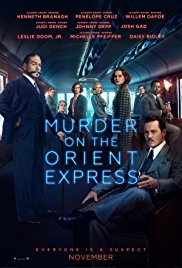Murder on the Orient Express – 3/5 – Movie Reviews by Ry!
 Murder on the Orient Express – 3/5 – Period pieces strike a specific cord. No matter what part of history, the balance of storytelling and capturing the era is prudent. From war, political dramas or romance, the period piece must create a space where the audience can enjoy the journey. Murder on the Orient Express happens within a specific era (1930s), while encapsulating the murder/mystery genre. Even with a well noted cast, the mystery of the crime stumbles to the finish. Even with some fragmented elements, Murder on the Orient Express is a fun tale that provides something interesting for fans of the genre.
Murder on the Orient Express – 3/5 – Period pieces strike a specific cord. No matter what part of history, the balance of storytelling and capturing the era is prudent. From war, political dramas or romance, the period piece must create a space where the audience can enjoy the journey. Murder on the Orient Express happens within a specific era (1930s), while encapsulating the murder/mystery genre. Even with a well noted cast, the mystery of the crime stumbles to the finish. Even with some fragmented elements, Murder on the Orient Express is a fun tale that provides something interesting for fans of the genre.
Premise: As a murder happens on a lavished train, the best detective in the world must figure out which of the passengers committed the crime.
The cast is an ensemble of many recognizable A-list actors/actresses. For the full list, please refer to the film’s IMDb page. Being an ensemble cast forces a balance between development of the individual and the period piece. Even with standard written characters, the actors/actresses’ portrayals are whimsical and authentic. The film’s stand out characters are:
Kenneth Branagh as Hercule Poirot
Daisy Ridley as Miss Mary Debenham
Josh Gad as Hector MacQueen
Michelle Pfeiffer as Caroline Hubbard
These individuals provide strength towards the course of the murder. You get a little more background development with these four because of a unique link to the murder investigation. This provides enough intrigue to the motive for everyone in the ensemble. Having broken apart from clichés of ‘good vs. bad’ archetypes, these four provide a mixture of unpredictable situations, outcomes and realistic relationship developments. Without these four, the ensemble cast would have fallen apart. Even with strong performance in the rest, there is only limited screen time for them. This causes some forced involvement for the sake of the source material.
The direction tackles the typical outline of any murder/mystery film. What makes this story stand slightly above is the period piece element. The setting of 1930s Europe allows for the era to engulf the audience with distinct atmosphere and tone. This unique flavor allows for a methodical approach to the standard dialogue, semi-characterization and general plot. With some details being fleshed out, it maneuvers specific reasons for each character to be part of the overall story. We are introduced to the list of characters in the first act, where the audience is given the place (train), conflict (murder of a passenger) and the mystery (motive of the passengers). This generic setup unfolds on a telegraph path for the murder. Even with strong acting, the archetypes reflect the obvious detail of the linear progression. Certain outcomes clash with the unique situations and witty draw of the individuals. Even with a clash of circumstance, the haze on who committed the murder provides a healthy distraction from the generic plot. As Hercule begins his investigation (in the second act), the film begins to reveal tantalizing details of characters. This meshing of motives and relationships causes some good and bad melodramatic situations. The investigation takes on the ‘person A talks to person B’ method, but the ambiguity of each character’s answers adds confusion. As each answer brings us closer to a suspect, the definition of who becomes bleak. This provides a dynamic of unpredictability to the overall murder. As Hercule tries to pinpoint exactly who did it, the question turns to towards if the crime itself was a terrible act. The heighten tension causes thrills, twists and turns to the fragility of the situation. Once in the third act, all comes to head when tempers boil and more lives are put in danger. Once the audience is confronted with the ultimate revelation, the climax provides an honest answer that is left open to interpretation. Even with an odd conclusion, you wonder about what could have been if it wasn’t for how much certain paths were telegraphed to lead to this outcome.
The cinematography is probably the best part of this film. Taking place on a train and in the 1930s, the colorful contrast with the ominous setting adds details in interesting ways. The outside landscapes provide an aura of encapsulation, while the train (itself) continually breathes life into the situation and setting. The score is mute at best, not having any real application to the enjoyment of the film.
Murder on the Orient Express has some strong detail and characters, but the generic outline of the plot brings everything to an average tale. Even with this outcome, there is a lot of fun to be had in the murderous journey. If you’re a fan of period pieces, murder/mysteries, this is one for you. I say it is worth going to the theaters at matinee price.